The genus Lilium are herbaceous flowering plants normally growing from bulbs. They comprise a genus of about 110 species in the lily family, Liliaceae. They are important as large showy flowering garden plants. They are important culturally and in literature in much of the world.
Some species are sometimes grown or harvested for the edible bulbs.
The species in this genus are the true lilies. Many other plants exist with "lily" in the common English name, some of which are quite unrelated to the true lilies.
[edit] Range
The range of liles in the Old World extends across much of Europe, the north Mediterranean region, across most of Asia to Japan, south to the Nilgiri mountains in India, and south to the Philippines. In the New World they extend from southern Canada through much of the United States.
They are commonly adapted to either woodland habitats, often montane, or sometimes to grassland habitats. A few can survive in marshland and a single one is known to live as an epiphyte (L. arboricola). In general they prefer moderately acidic or lime-free soils.
[edit] Botany

Lilies are leafy stemmed herbs. They form naked or tunic-less scaly underground bulbs from which they overwinter. In some North American species the base of the bulb develops into rhizomes, on which numerous small bulbs are found. Some species develop stolons. A few species form near the soil surface.
Many species form stem-roots. With these, the bulb grows naturally at some depth in the soil, and each year the new stem puts out adventitious roots above the bulb as it emerges from the soil. These roots are in addition to the basal roots that develop at the base of the bulb.
Most species are deciduous, but a few species (Lilium candidum, Lilium catesbaei) bear a basal rosette of leaves during dormancy.
Seeds ripen in late summer. They exhibit varying and sometimes complex germination patterns, many adapted to cool temperate climates.
The large flowers have six tepals, are often fragrant, and come in a range of colours ranging through whites, yellows, oranges, pinks, reds and purples. Markings include spots, brush strokes and picotees. The plants are summer flowering.
Some species formerly included within this genus have now been placed in other genera. These include Cardiocrinum, Notholirion, Nomocharis and some Fritillaria.
[edit] Taxonomy
[edit] Section Martagon
 | Lilium distichum | |
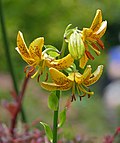 | Lilium hansonii | |
 | Lilium martagon | Martagon or Turk's cap lily |
 | Lilium medeoloides | |
 | Lilium tsingtauense | |
 | Lilium debile |
[edit] Section Pseudolirium
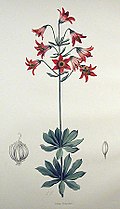 | Lilium bolanderi | |
 | Lilium columbianum | Columbia Lily or Tiger Lily |
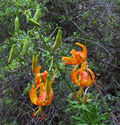 | Lilium humboldtii | Humboldt's lily |
 | Lilium kelloggii | |
 | Lilium rubescens | |
 | Lilium washingtonianum | Washington Lily, Shasta Lily, or Mt. Hood Lily |
 | Lilium kelleyanum | |
 | Lilium maritimum | |
 | Lilium occidentale | |
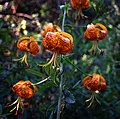 | Lilium pardalinum | Panther or Leopard lily |
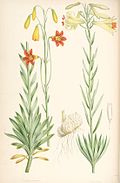 | Lilium parryi | |
 | Lilium parvum | Sierra tiger lily or Alpine lily |
 | Lilium canadense | Canada Lily or Meadow Lily |
 | Lilium puberulum | |
 | Lilium grayi | |
 | Lilium iridollae | |
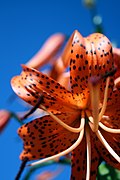 | Lilium michiganense | Michigan Lily |
 | Lilium michauxii | Carolina Lily |
| Lilium pyrophilum | ||
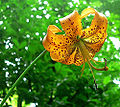 | Lilium superbum | Swamp lily or American tiger lily |
 | Lilium catesbaei | |
 | Lilium philadelphicum | Wood lily, Philadelphia lily or prairie lily |
[edit] Section Liriotypus
 | Lilium bulbiferum | Orange Lily or Fire Lily |
 | Lilium candidum | Madonna lily |
 | Lilium chalcedonicum | |
 | Lilium kesselringianum | |
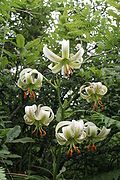 | Lilium ledebourii | |
 | Lilium szovitsianum | |
 | Lilium monadelphum | |
 | Lilium pyrenaicum | |
 | Lilium rhodopeum | |
 | Lilium akkusianum | |
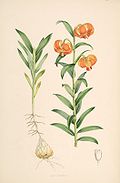 | Lilium carniolicum | |
 | Lilium ciliatum | |
 | Lilium pomponium | Turban lily |
 | Lilium ponticum | |
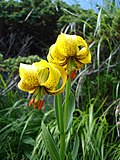 | Lilium jankae | |
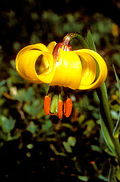 | Lilium albanicum | |
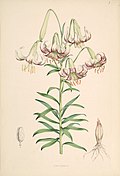 | Lilium polyphyllum |
[edit] Section Archelirion
 | Lilium auratum | Golden rayed lily of Japan, or Goldband lily |
| Lilium platyphyllum | ||
| Lilium brownii | ||
| Lilium japonicum | ||
| Lilium nobilissimum | ||
| Lilium rubellum | ||
 | Lilium speciosum | Japanese lily |
[edit] Section Sinomartagon
| Lilium davidii | ||
 | Lilium duchartrei | |
| Lilium henryi | Tiger Lily or Henry's lily | |
 | Lilium lancifolium | Tiger Lily |
| Lilium lankongense | ||
| Lilium leichtlinii | ||
| Lilium papilliferum | ||
| Lilium rosthornii | ||
| Lilium amabile | ||
| Lilium callosum | ||
| Lilium cernuum | ||
| Lilium concolor | ||
| Lilium fargesii | ||
| Lilium pumilum | ||
| Lilium xanthellum | ||
| Lilium amoenum | ||
| Lilium bakerianum | ||
| Lilium henrici | ||
| Lilium lijiangense | ||
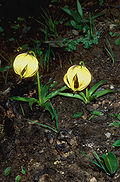 | Lilium lophophorum | |
 | Lilium mackliniae | Siroi Lily |
| Lilium nanum | ||
 | Lilium nepalense | |
| Lilium oxypetalum | ||
| Lilium paradoxum | ||
| Lilium primulinum | ||
| Lilium sempervivoideum | ||
| Lilium sherriffiae | ||
| Lilium souliei | ||
| Lilium stewartianum | ||
| Lilium taliense | ||
 | Lilium wardii | |
| Lilium arboricola | ||
| Lilium anhuiense | ||
| Lilium brevistylum | ||
 | Lilium habaense | |
| Lilium huidongense | ||
| Lilium jinfushanense | ||
| Lilium matangense | ||
| Lilium pinifolium | ||
| Lilium pyi | ||
| Lilium saccatum | ||
| Lilium tianschanicum | ||
| Lilium poilanei | ||
| Lilium floridum | ||
| Lilium medogense |
[edit] Section Leucolirion
| Lilium leucanthum | ||
| Lilium puerense | ||
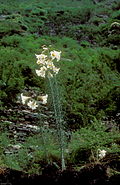 | Lilium regale | |
| Lilium sargentiae | ||
| Lilium sulphureum | ||
| Lilium formosanum | ||
 | Lilium longiflorum | Easter Lily or November Lily |
| Lilium philippinense | ||
| Lilium wallichianum | ||
| Lilium wenshanense |
[edit] Section Daurolirion
| Lilium pensylvanicum | |
| Lilium maculatum |
[edit] Section not specified
| Lilium eupetes |
[edit] Uses
Many species are widely grown in the garden in temperate and sub-tropical regions. Sometimes they may also be grown as potted plants. A large number of ornamental hybrids have been developed. They can be used in herbaceous borders, woodland and shrub plantings, and as a patio plant.
Some lilies, especially Lilium longiflorum, as well as a few other hybrids, form important cut flower crops. These tend to be forced for particular markets; for instance, L. longiflorum for the Easter trade, when it may be called the Easter lily.
Lilium bulbs are starchy and edible as root vegetables, although bulbs of some species may be very bitter. The non-bitter bulbs of L. lancifolium, L. pumilum, and especially L. brownii (Chinese: 百合 干; pinyin: bǎihé gān) are grown at large scale in China as a luxury or health food, most often sold in dry form. They are eaten especially in the summer, for their ability to reduce internal heat. They may be reconstituted and stir-fried, grated and used to thicken soup, or processed to extract starch. Their texture and taste draw comparison with the potato, although the individual bulb scales are much smaller.
Although they are believed to be safe for humans to eat, there are reports of nephrotoxicosis (kidney failure) in cats which have eaten some species of Lilium and Hemerocallis[1].
Lilies are used as food plants by the larvae of some Lepidoptera species including The Dun-bar.